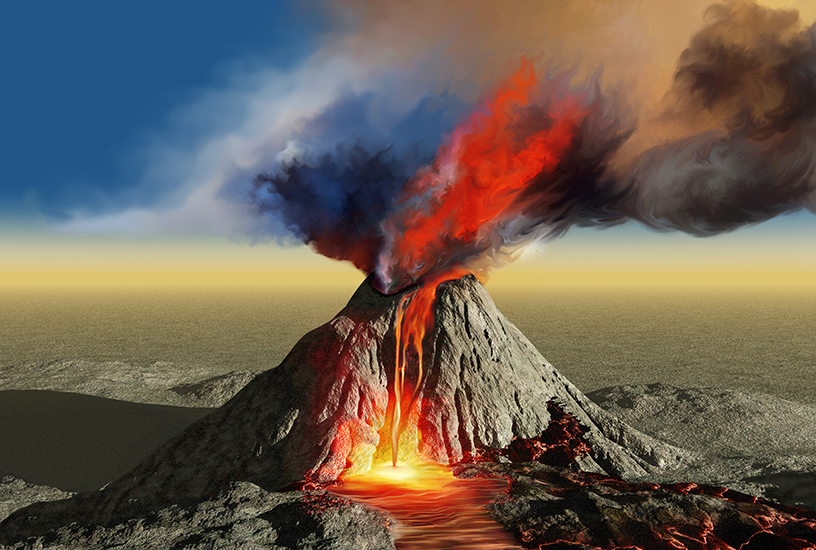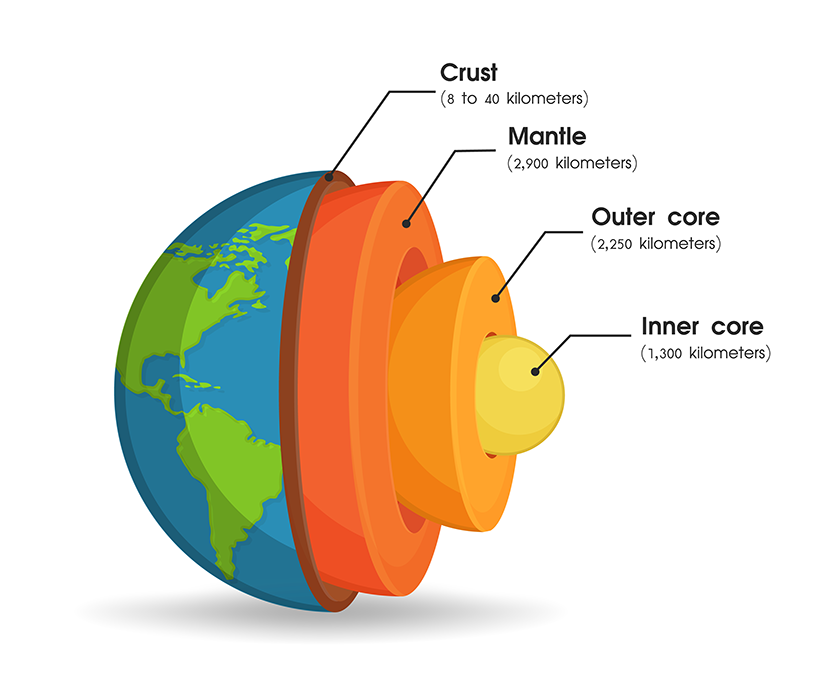Classroom Volcanoes

AUSTRALIAN CURRICULUM ALIGNMENT
- The theory of plate tectonics explains global patterns of geological activity and continental movement
- Relating the occurrence of earthquakes and volcanic activity to constructive and destructive plate boundaries
BACKGROUND
The Earth’s structure is comprised of many layers; however, it consists of three basic parts: the core, mantle and crust. The core is separated into two layers: inner and outer (see Figure 1). As the hottest thing on earth, you wouldn’t expect the inner core to be solid, but the intense pressure exerted on it maintains a stable, solid form. The outer core is not required to withstand the same levels of pressure and thus, is liquid. The mantle, which makes up 84% of the total volume of our planet, lies between Earth’s outer crust and its core. Similar to the core, the mantle is divided into regions. The mesosphere layer of the mantle surrounds the outer core, and is very rigid. Lying on top of the mesosphere is the asthenosphere. The asthenosphere is slow moving and viscous. The lithosphere is the uppermost layer of the mantle and it remains cool, due to its distance away from earth’s heat radiating core. This layer contains rigid, brittle rock and forms part of Earth’s outer shell.

Figure 1: Layers of the Earth
Also contained within the lithosphere, is the earth’s crust. The Earth’s crust is composed of oceanic or continental crusts. The continental crust is thicker but less dense than oceanic crust; however, both are comprised of solid rock. As temperatures and/or pressure increases, sections of the lithosphere melt to form molten rock. Molten rock that forms underground, magma, amasses in magma chambers (pockets under the crust). When specific temperatures and pressures are reached within the magma chamber, magma is expelled into the Earth’s crust. Volcanoes form when these high-pressure magma chambers are located near weak places in the earth’s crust. The chambers expel magma, causing the crust to break open and form a volcano. The function of a volcano is to allow gas and lava (previously molten rock) to escape to the surface of the earth.
PREPARATION - BY LAB TECHNICIAN
-
Light a red or orange candle using a lighter or match. Allow the candle to burn and melt for a few moments.
- Hold the beaker tilted slightly horizontally to one side and pour melted candle wax into one side of it, close to the bottom.
- Continue dripping until you have accumulated approximately 2 tsp of wax.
- Allow the melted wax to cool and solidify for 5 minutes.
- Pour a 1-inch layer of sand in the beaker over the wax.
- Pour water in the beaker, over the sand and wax until ¾ full.
- Stir the sand with a spoon gently to dampen it. Stir carefully to avoid dislodging the melted wax.
- Allow 1 minute for the sand to settle.
METHOD - STUDENT ACTIVITY
-
Slowly heat the prepared beaker of wax, sand, and water on a hot plate using a medium heat.
- The wax will push up into the sand layer as it melts.
- You may hear a faint bubbling sound during this time or see bulges form in the sand.
- After a time, the melted wax will rise through the sand, and solidify as it enters the cool water.
- If the wax has not broken through the sand after 5 minutes, increase the hot plate temperature.
- Turn the hot plate off when the wax is no longer breaking through the sand.
- Let the beaker and hot plate rest for 20 min to cool.
- Once cooled, safely remove the beaker from the hot plate and clean thoroughly. The sand, water, and wax are not reusable at this point.
OBSERVATION AND RESULTS
Students will observe the melted wax will rise through the sand, and solidify as it enters the cool water.INVESTIGATIONS
-
Ask students to describe what is occurring within the beaker and how it mirrors what occurs in volcano formations.
- Discuss how the temperature increase forms a pocket of melted wax beneath the sand much like a pocket of magma forms in magma chamber beneath the crust and/or lithosphere.
- Discuss how the temperature increases in the beaker and subsequent increase in pressure mirrors volcanic activity prior to eruption.
- Explain how the melted wax expanding and pushing up into the layer of sand directly illustrates what occurs during a volcanic eruption. When the melted wax (magma) breaks through the layer of sand it comes gushing out into the water (volcanic eruption of lava).
- Explore both land and water volcanic eruptions. Discuss how the water represents the atmosphere in a land eruption and whereas it represents water in an underwater volcanic eruption. Explain the differences and similarities of these two types of eruption.
EXTENSION EXERCISES
-
Ask students to research where volcanoes occur, different types of volcanoes, and the conditions that characterise each.
- Ask students to research the thickness of each layer of Earth’s interior and ask them to use proportions to calculate measurements scaled to fit on a piece of paper. Students can then draw a scale model on paper using a ruler and compass.
 Time Requirements
Time Requirements
- 45 mins
 Material List
Material List
- Candle (Red or Orange)
- Sand
- Glass Beaker (400 mL)
- Spoon
- Water
- Hot Plate
- Matches or Lighter
 Safety Requirements
Safety Requirements
- Wear appropriate personal protective equipment (PPE). It is critical to wear safety glasses to prevent risk of hot wax causing eye damage. Wear protective gloves when handling hot wax and glass beaker to prevent skin burns.
- Know and follow all regulatory guidelines for the disposal of laboratory wastes.
